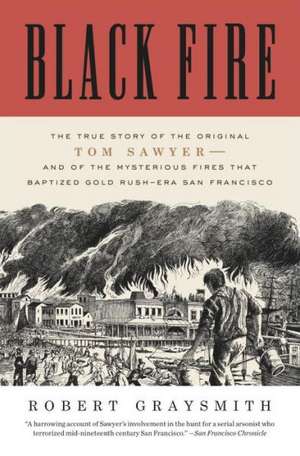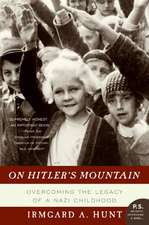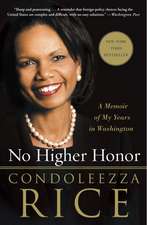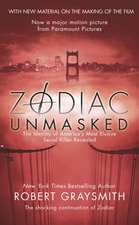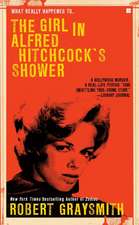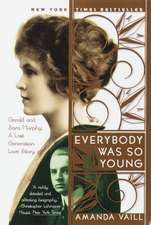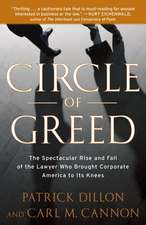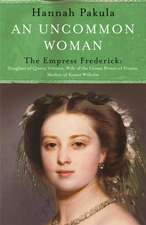Black Fire: The True Story of the Original Tom Sawyer--And of the Mysterious Fires That Baptized Gold Rush-Era San Francisco
Autor Robert Graysmithen Limba Engleză Paperback – 28 oct 2013
When 28-year-old San Francisco Daily Morning Call reporter Mark Twain met Tom Sawyer at a local bathhouse in 1863, he was seeking a subject for his first novel. As Twain steamed, played cards, and drank beer with Sawyer (a volunteer firefighter, customs inspector, and local hero responsible for having saved ninety lives at sea), he had second thoughts about Shirley Tempest, his proposed book about a local girl firefighter, and began to envision a novel of wider scope. Twain learned that a dozen years earlier the then eighteen-year-old New York-born Sawyer had been a “Torch Boy,” one of the youths who raced ahead of the volunteer firemen’s hand-drawn engines at night carrying torches to light the way, always aware that a single spark could reduce the all-wood city of San Francisco to ashes in an instant. At that time a mysterious serial arsonist known by some as “The Lightkeeper” was in the process of burning San Francisco to the ground six times in eighteen months ߝ the most disastrous and costly series of fires ever experienced by any American metropolis.
Black Fire is the most thorough and accurate account of Sawyer’s relationship with Mark Twain and of the six devastating incendiary fires that baptized one of the modern world’s favorite cities. Set amid a scorched landscape of burning roads, melting iron warehouses, exploding buildings, and deadly gangs who extorted and ruled by fear, it includes the never-before-told stories of Sawyer’s heroism during the sinking of the steamship Independence and the crucial role Sawyer and the Torch Boys played in solving the mystery of the Lightkeeper.
Drawing on archival sources such as actual San Francisco newspaper interviews with Sawyer and the handwritten police depositions of the arrest of the Lightkeeper, bestselling author Robert Graysmith vividly portrays the gritty, corrupt, and violent world of Gold Rush-era San Francisco, overrun with gunfighters, hooligans, hordes of gold prospectors, crooked politicians, and vigilantes. By chronicling how Sawyer took it upon himself to investigate, expose, and stop the arsonist, Black Fire details ߝ for the first time ߝ Sawyer’s remarkable life and illustrates why Twain would later feel compelled to name his iconic character after his San Francisco buddy when he wrote The Adventures of Tom Sawyer.
Preț: 82.48 lei
Nou
Puncte Express: 124
Preț estimativ în valută:
15.78€ • 16.39$ • 13.16£
15.78€ • 16.39$ • 13.16£
Carte disponibilă
Livrare economică 03-17 martie
Preluare comenzi: 021 569.72.76
Specificații
ISBN-13: 9780307720573
ISBN-10: 0307720578
Pagini: 268
Ilustrații: 20 ILLUSTRATIONS AND MAPS T/O
Dimensiuni: 132 x 205 x 20 mm
Greutate: 0.25 kg
Editura: BROADWAY BOOKS
ISBN-10: 0307720578
Pagini: 268
Ilustrații: 20 ILLUSTRATIONS AND MAPS T/O
Dimensiuni: 132 x 205 x 20 mm
Greutate: 0.25 kg
Editura: BROADWAY BOOKS
Recenzii
"A harrowing account of Sawyer's involvement in the hunt for a serial arsonist who terrorized mid-nineteenth century San Francisco." ߝ San Francisco Chronicle
“Graysmith has amassed an impressive amount of historical detail….A well-researched work about community and fire.” ߝ Cleveland Plain Dealer
“The journalist delved deep into archival material to find the connection between Mark Twain and a heroic San Francisco firefighter named Tom Sawyer, who became the model for one of Twain's most beloved characters.” ߝ Sacramento Bee
"Fascinating." ߝSan Jose Mercury News
"A sizzling tale...[Graysmith] uncovers Mark Twain's friendship with the real-life Sawyer — a colorful figure in the city's early firefighting culture — and paints a detailed portrait of San Francisco, circa 1849-1866. It's jam-packed with notable residents whose long-ago importance lingers in the city's street names (Broderick, Brannan) — plus mustachioed hooligans and "The Lightkeeper," an arsonist as mysterious as he was destructive." ߝ San Francisco Bay Guardian
“Mark Twain fanatics and firefighter-history buffs alike will flock to the tale of the real-life Tom Sawyer’s adventures fighting fires in the Gold Rushߝera city, depicted in remarkable detail by Graysmith…Black Fire captures the spirit of rugged adventure so beloved in Twain’s work and so characteristic of the undaunted city built—time and time again—on the hopes of fortune-hunters.” ߝ Booklist
“Rich…lively and chock-full of eye-opening tidbits” ߝ Kirkus Reviews
"Packing a whirlwind of events around dizzying details of boggy, impassable streets choked with decaying refuse, characters of all manner of disrepute, throughout a booming city haphazardly constructed of highly flammable material, Graysmith (who also drew the book's illustrations) inserts a teenage Tom Sawyer, newly migrated from the east, into one of the most tumultuous periods in San Francisco's storied history... the book truly shines."ߝ Publishers Weekly
“Graysmith has amassed an impressive amount of historical detail….A well-researched work about community and fire.” ߝ Cleveland Plain Dealer
“The journalist delved deep into archival material to find the connection between Mark Twain and a heroic San Francisco firefighter named Tom Sawyer, who became the model for one of Twain's most beloved characters.” ߝ Sacramento Bee
"Fascinating." ߝSan Jose Mercury News
"A sizzling tale...[Graysmith] uncovers Mark Twain's friendship with the real-life Sawyer — a colorful figure in the city's early firefighting culture — and paints a detailed portrait of San Francisco, circa 1849-1866. It's jam-packed with notable residents whose long-ago importance lingers in the city's street names (Broderick, Brannan) — plus mustachioed hooligans and "The Lightkeeper," an arsonist as mysterious as he was destructive." ߝ San Francisco Bay Guardian
“Mark Twain fanatics and firefighter-history buffs alike will flock to the tale of the real-life Tom Sawyer’s adventures fighting fires in the Gold Rushߝera city, depicted in remarkable detail by Graysmith…Black Fire captures the spirit of rugged adventure so beloved in Twain’s work and so characteristic of the undaunted city built—time and time again—on the hopes of fortune-hunters.” ߝ Booklist
“Rich…lively and chock-full of eye-opening tidbits” ߝ Kirkus Reviews
"Packing a whirlwind of events around dizzying details of boggy, impassable streets choked with decaying refuse, characters of all manner of disrepute, throughout a booming city haphazardly constructed of highly flammable material, Graysmith (who also drew the book's illustrations) inserts a teenage Tom Sawyer, newly migrated from the east, into one of the most tumultuous periods in San Francisco's storied history... the book truly shines."ߝ Publishers Weekly
Notă biografică
Robert Graysmith is the New York Times bestselling author of Zodiac and eight other books. The major motion pictures Zodiac and Auto Focus are based on his books. A San Francisco Chronicle political cartoonist and artist for fifteen years, he lives in San Francisco.
Extras
CHAPTER ONE
Broderick and the Christmas Eve Catastrophe
Tom Sawyer had known from the beginning that the fierce competition between the volunteer companies would eventually destroy them all. In 1844, when he was twelve, his job as a torch boy for Columbia Hook and Ladder Company Number Fourteen, an outstanding company of New York fire volunteers, had brought him face-to-face with the deadly consequences of such bitter rivalry. During a race between Number Five Engine and Fourteen Engine through Chambers Street to reach a fire first, one of Fourteen’s runners fell, and their 4,200-pound double-deck Philadelphia-style engine passed over him, catching him in the back with the kingbolt. As the boy lay broken and dying on the pavement, he raised his head and called out, “Go on, Fourteen!” His last words became the rallying cry of Sawyer’s company as they worked that night with the stroke pump. The pump with handles fixed on either end required seven men on each set of brakes, bars by which hand-pumped fire engines are operated. Exhausted by night’s end, they did not mind. The backbreaking labor helped them forget their sorrow.
“There’s always a crowd of boys,” one observer said, “victims of poverty and pinching and eager to earn some pennies, who vie with each other to run before the engines and hold aloft the torches that light the way.” As a boy, Sawyer’s occupations had been varied. Born in Brooklyn on January 1, 1832, he had worked in a bakery and shucked oysters in Washington Market until his fingers were bleeding. But running with the engines was his passion. At age nine he had been a signal boy for the immortal Cornelius Ruderson’s Hudson Number One and vividly recalled their firehouse in a lane (now Barclay Street) running down to the North River. It exhilarated him to race before the heavy engine to lead the way with a lantern on a pole over his shoulder. One engine company, Number Fifteen, had two teams of runners, the Fly-By-Nights and the Old Maid’s Boys, who could beat any other company to a fire. Sawyer’s Number Fourteen, known as the Wide Awake, had only fourteen men, who were pampered lavishly by their sponsors with well-furnished parlors and well-appointed bunks in an engine house under the protective wing of St. Paul’s Chapel. Being a volunteer was a badge of honor and made a man somebody. Such men who risked their lives for no pay were celebrities. Some were impersonated on stage in a series of plays.
Fourteen’s new neighbor and greatest rival was Howard Engine Company Thirty-four, named after Harry Howard, an orphan firefighter. They had relocated their firehouse on Amos Street to Greenwich Village at the northwest corner of Hudson and Christopher streets, just southwest of Washington Square. Thirty-four’s greatest volunteer was David Colbert Broderick, a gifted stone quarrier and man among men. He was darkly handsome, compact and muscular. His startling blue eyes were hidden under thick dark brows. The long line of a knife scar trailed along Broderick’s cheek. The raised scar displayed itself boldly whenever he experienced strong emotion. For that reason, he had cultivated a dark reddish beard to hide the imperfection. It was a Dutch beard with the upper and lower lip clean-shaven. He had gotten the wound not in a war but during a battle with a Manhattan volunteer fire company. “There was a natural human competition between our New York companies to turn out the quickest,” Broderick said. Engine Company Twenty-six’s battles with Company Two and Company One Hundred and Nineteen were already legendary. Broderick’s chief rival in a competing unit, Protection Company Number Five, was Davey Scannell.
Because of the tremendous opportunities for political advancement afforded by being affiliated with a firehouse, the number of New York fire companies rocketed to sixty-four volunteer units with sixteen hundred blue-stockinged, exceedingly fit municipal workers constantly on call. Men fought to arm themselves with hooks and leather buckets, to callous their hands on pump and ax handles--to pump, chop, and scorch--anything to defeat a big blaze. Such huge numbers created a system so complex that a chief engineer, responsible for the care and operation of the fire engine, was appointed.
“We had a natural inclination to be first at the scene.” Broderick continued. “Who wouldn’t want to be first to extinguish the flames? First! God help us. We had to be first!” He pounded his fist. “But this competitive urge took a violent turn. Soon it was common for Company Number Thirty-four, my squad, the Red Rovers (named after the Cooper sea tale), to fight pitched battles (we called these ‘scrimmages’) for the honor of being first to put out a blaze while buildings burned to the ground. Guns and knives were frowned on, so we fought with the tools of our trade--hose butts, half spanners [hose couplers], blunderbusses, pipes [nozzles], wrenches, pry bars, ax handles . . . anything handy.” A champion of weaker men, he was a first-rate bare-knuckle boxer, with the sloping shoulders of a powerful fighter toughened by a hundred street battles. “Now my strategy back in New York was to settle the conflict as fast as I could,” Broderick said. “I would pick out the biggest guy the other company had to offer and take him on one to one--that’s how I got this”--he ran the tip of his index finger along the long, thin line trailing under his beard. “I usually got beat by powerhouses like Mose Cutter, but I rallied my men each time.” Broderick lost to the strongest the other companies had to offer. His enemies grew to respect him for standing up to them and never giving up.
Even to those who knew him best, Broderick remained a strange, extraordinary lone man who was rarely happy, often gloomy. Even in his youth he wore a savage scowl upon his face. Sawyer suspected the tough Irishman never smiled because he was in mourning. “He has no family left anywhere in the wide world,” he said. Broderick, born February 4, 1820, in Washington, D.C., was the son of an immigrant father, a gifted stonemason and ornamental worker in marble. His father had carved the huge marble columns and capitals for the east front of the Capitol Building and the Senate Chamber and finished the interior decorative work in 1834. Broderick’s family moved to New York, where his father became superintendent of a marble yard. His father, of feeble constitution, died two years later from his extreme labors. When Broderick’s mother passed away in 1843, he cared for his younger brother. A year later his brother died in a construction site explosion when a bombshell in Duval’s Foundry Yard accidentally burst.
He grew up in the roughest quarter of New York City, the notorious lower Manhattan slum the Sixth Ward, which contained the Five Points District. For five years he served an apprenticeship to a stonecutter in a yard at Washington and Barron streets. He called it one of the most laborious mechanical trades pursued by man, “an occupation that from its nature devotes its followers to thought, but debars him from conversation. I am the son of an artisan and have been a machine . . . I am not proud of this. I am sorry it is true. I would that I could have enjoyed the pleasure of life in my boyhood days, but they were denied to me, to my sorrow.” He cut stone with a toothless, water-and-sand-driven, soft-iron gang saw in fifteen quarries on the East Side and on the East Aspetuck River. On tougher jobs, he used a saw-toothed implement with diamonds brazed into a blade that could slice through anything. With the help of well-placed charges of gunpowder, he carved huge blocks from the quarries. While serving at a minor post at the U.S. Custom House in New York City, Broderick joined Number Thirty-four on Gouverneur Street, where he worked their side-stroke, piano-style engine (so named because of the shape of its water box). This early pumper had seven-inch cylinders, a five-inch stroke, and a gooseneck--a swivel-jointed tube in the discharge pipe that let him accurately direct a jet of water. When Broderick, widely admired for his leadership, was promoted on May 13, 1844, his new helmet emblem, shaped like a detective’s badge, was inscribed with the words “Foreman,” “34,” and “D. C. B.” arranged in a neat rectangle.
“Goldilocks,” one of the Red Rovers’ young runners, was so brightly golden haired that Broderick joked, “We’ll never need boys with signal lights when he is forefront at the rope.”
Under Broderick, the Red Rovers challenged Sawyer’s Fourteen to a “washing.” To lose at a washing was one of the worst catastrophes that could befall a volunteer fireman. To play water on a fire, the engines had to line up from the source of water to the fire, one engine pumping water into another, and so on down the line. If, in the process of transferring the water, one engine could not handle the water pumped into it by the preceding machine, it was “washed” and, in the eyes of the members of other companies, disgraced. The battle between Fourteen and the Red Rovers took place at night in Mackerville, one of the roughest districts in New York City and a common battleground for the “fightingest” Irish. It was a place of squatters, tin can mansions, and shanties around Fourteenth Street and Avenue A and Avenue B. Sawyer’s foreman, Venn, coaxed, cursed, and coddled his men for hours. A cry of “She’s up to the rabbits! She’s over!” came ringing through the cheers of the Red Rovers. They were victorious over Fourteen’s machines. Fourteen was so stunned, some men cried as they lay on the ground exhausted. The “Mackereville washing” was one of the most exciting contests of the day.
“Although his origin was lowly,” it was said of Broderick, “he felt stir within himself the forces of a strong nature. Though his associations were debased, he was not bound down by them and continued to rise year by year on the shoulders of the electors of the Ninth Ward.” He was lifted to fame by his intense personal magnetism, marvelous knowledge of men, and absolute integrity. “He learned how to work hard, handle men and get what he wanted. He was no orator, but a man made for action . . . a populist whose strength of character was only rivaled by its complexity.”
In 1840, Broderick had been a ward heeler for Tammany Hall, the corrupt political machine of William Marcy Tweed. “Boss” Tweed yearned to be foreman of a New York volunteer fire company in the Democratic Ninth Ward that extended to the Hudson River west of Washington Square (now Greenwich Village) and housed New York’s three most popular fire companies. Tweed joined several units before becoming foreman of Big Six, whose seal was a growling tiger painted on the body panel of their pumper. Tweed knew any political boss who affiliated himself with a district firehouse as their benefactor acquired that unit’s prestige and great influence it wielded in their community. By allying himself, he gained not only a block of local voters but also a gang of street toughs to intimidate any opposition. The volunteers, tangible symbols of his authority, cracked heads at political rallies and got out the vote for him. When Boss Tweed became New York’s “King of Corruption,” cartoonist Thomas Nast refashioned the tiger into a symbol of Tweed’s corrupt organization: the infamous Tammany Tiger. He incited such public outrage that his scathing cartoons eventually brought Tweed down.
In 1845, the electors of the Sixth Ward in the Bowery tapped Broderick to receive the Democratic nomination for Congress. As a devout Irish Catholic, he believed he could “make more reputation by being an honest man instead of a rascal.” If he was elected, he could make a difference, but he lost to a Whig.
Broderick was a man of contradictions. Though he didn’t smoke, gamble, or drink, he ran a New York tavern, the Subterranean, at the corner of King and Hudson streets, which catered to Irish laborers. Behind the bar he wore rough workingman’s clothes, the class with which he most identified, yet read the great works of philosophy and literature, especially the poetry of Shelley. At the request of Colonel Jonathan Drake Stevenson, who was raising a company of soldiers to fight in the Mexican War, Broderick sold his saloon, poured the remaining barrels of whiskey down the gutter, and on April 17, 1849, resigned from the Red Rovers. As a parting gift, his men presented him with a heavy-duty, double-cased gold pocket watch. He set out from Manhattan for San Francisco, but hostilities had ceased by the time Stevenson’s men reached the Pacific Coast. The tortuous trip crossing Central America damaged Broderick’s health and he arrived in San Francisco on June 13, penniless and sick. The first day he vowed: “I tell you, Sir, by God, that for one hour’s seat in the Senate of the United States, I would roast before a slow fire in the Square! I’ll go if I have to march over a thousand corpses and every corpse a friend!”
His friend, Fred Kohler, a forty-year-old jeweler, assayer, former alderman, and volunteer assistant engineer in New York, joined him in San Francisco. Broad, clean-shaven, with muttonchops and a long straight mouth, Kohler had the stolid demeanor of a Quaker. In the summer, Stevenson pointed out to Broderick and Kohler that although gold flowed in rivers from the mines, gold coins were virtually unattainable in the Bay Area. The only coins accepted in San Francisco as legal tender were English shillings, French francs, and Mexican double reales--all of the same value. It would be almost ten years before San Francisco would have a government assay office to buy raw gold or a mint to manufacture coin more convenient than cumbersome buckskin pouches of gold dust. Kohler, who was clever with his hands, melted up the gold dust an idled Colonel Stevenson had bought west for fourteen dollars an ounce and cast it in five-, ten-, and twenty-dollar slugs. He and Broderick profited by putting four dollars’ worth of gold into a five-dollar piece and eight dollars’ worth into a ten-dollar coin. The muscular Broderick sweated before the furnace, striking coins from gold ingots, and casting and filing the slightly debased coins. As the first to coin money locally, as well as assay and stamp gold bars in their Clay Street office, they made enough by minting for Moffat and Company to retire for life. By Christmas Eve, 1849, Sawyer, who had followed Broderick to the goldfields, had been at sea for about two-thirds of his estimated five-month voyage to San Francisco. His ship, the Splendid, was battling the high waves and storms of Cape Horn. Sawyer was eager to become rich in the diggings and expected to reach the city by mid-February.
Broderick and the Christmas Eve Catastrophe
Tom Sawyer had known from the beginning that the fierce competition between the volunteer companies would eventually destroy them all. In 1844, when he was twelve, his job as a torch boy for Columbia Hook and Ladder Company Number Fourteen, an outstanding company of New York fire volunteers, had brought him face-to-face with the deadly consequences of such bitter rivalry. During a race between Number Five Engine and Fourteen Engine through Chambers Street to reach a fire first, one of Fourteen’s runners fell, and their 4,200-pound double-deck Philadelphia-style engine passed over him, catching him in the back with the kingbolt. As the boy lay broken and dying on the pavement, he raised his head and called out, “Go on, Fourteen!” His last words became the rallying cry of Sawyer’s company as they worked that night with the stroke pump. The pump with handles fixed on either end required seven men on each set of brakes, bars by which hand-pumped fire engines are operated. Exhausted by night’s end, they did not mind. The backbreaking labor helped them forget their sorrow.
“There’s always a crowd of boys,” one observer said, “victims of poverty and pinching and eager to earn some pennies, who vie with each other to run before the engines and hold aloft the torches that light the way.” As a boy, Sawyer’s occupations had been varied. Born in Brooklyn on January 1, 1832, he had worked in a bakery and shucked oysters in Washington Market until his fingers were bleeding. But running with the engines was his passion. At age nine he had been a signal boy for the immortal Cornelius Ruderson’s Hudson Number One and vividly recalled their firehouse in a lane (now Barclay Street) running down to the North River. It exhilarated him to race before the heavy engine to lead the way with a lantern on a pole over his shoulder. One engine company, Number Fifteen, had two teams of runners, the Fly-By-Nights and the Old Maid’s Boys, who could beat any other company to a fire. Sawyer’s Number Fourteen, known as the Wide Awake, had only fourteen men, who were pampered lavishly by their sponsors with well-furnished parlors and well-appointed bunks in an engine house under the protective wing of St. Paul’s Chapel. Being a volunteer was a badge of honor and made a man somebody. Such men who risked their lives for no pay were celebrities. Some were impersonated on stage in a series of plays.
Fourteen’s new neighbor and greatest rival was Howard Engine Company Thirty-four, named after Harry Howard, an orphan firefighter. They had relocated their firehouse on Amos Street to Greenwich Village at the northwest corner of Hudson and Christopher streets, just southwest of Washington Square. Thirty-four’s greatest volunteer was David Colbert Broderick, a gifted stone quarrier and man among men. He was darkly handsome, compact and muscular. His startling blue eyes were hidden under thick dark brows. The long line of a knife scar trailed along Broderick’s cheek. The raised scar displayed itself boldly whenever he experienced strong emotion. For that reason, he had cultivated a dark reddish beard to hide the imperfection. It was a Dutch beard with the upper and lower lip clean-shaven. He had gotten the wound not in a war but during a battle with a Manhattan volunteer fire company. “There was a natural human competition between our New York companies to turn out the quickest,” Broderick said. Engine Company Twenty-six’s battles with Company Two and Company One Hundred and Nineteen were already legendary. Broderick’s chief rival in a competing unit, Protection Company Number Five, was Davey Scannell.
Because of the tremendous opportunities for political advancement afforded by being affiliated with a firehouse, the number of New York fire companies rocketed to sixty-four volunteer units with sixteen hundred blue-stockinged, exceedingly fit municipal workers constantly on call. Men fought to arm themselves with hooks and leather buckets, to callous their hands on pump and ax handles--to pump, chop, and scorch--anything to defeat a big blaze. Such huge numbers created a system so complex that a chief engineer, responsible for the care and operation of the fire engine, was appointed.
“We had a natural inclination to be first at the scene.” Broderick continued. “Who wouldn’t want to be first to extinguish the flames? First! God help us. We had to be first!” He pounded his fist. “But this competitive urge took a violent turn. Soon it was common for Company Number Thirty-four, my squad, the Red Rovers (named after the Cooper sea tale), to fight pitched battles (we called these ‘scrimmages’) for the honor of being first to put out a blaze while buildings burned to the ground. Guns and knives were frowned on, so we fought with the tools of our trade--hose butts, half spanners [hose couplers], blunderbusses, pipes [nozzles], wrenches, pry bars, ax handles . . . anything handy.” A champion of weaker men, he was a first-rate bare-knuckle boxer, with the sloping shoulders of a powerful fighter toughened by a hundred street battles. “Now my strategy back in New York was to settle the conflict as fast as I could,” Broderick said. “I would pick out the biggest guy the other company had to offer and take him on one to one--that’s how I got this”--he ran the tip of his index finger along the long, thin line trailing under his beard. “I usually got beat by powerhouses like Mose Cutter, but I rallied my men each time.” Broderick lost to the strongest the other companies had to offer. His enemies grew to respect him for standing up to them and never giving up.
Even to those who knew him best, Broderick remained a strange, extraordinary lone man who was rarely happy, often gloomy. Even in his youth he wore a savage scowl upon his face. Sawyer suspected the tough Irishman never smiled because he was in mourning. “He has no family left anywhere in the wide world,” he said. Broderick, born February 4, 1820, in Washington, D.C., was the son of an immigrant father, a gifted stonemason and ornamental worker in marble. His father had carved the huge marble columns and capitals for the east front of the Capitol Building and the Senate Chamber and finished the interior decorative work in 1834. Broderick’s family moved to New York, where his father became superintendent of a marble yard. His father, of feeble constitution, died two years later from his extreme labors. When Broderick’s mother passed away in 1843, he cared for his younger brother. A year later his brother died in a construction site explosion when a bombshell in Duval’s Foundry Yard accidentally burst.
He grew up in the roughest quarter of New York City, the notorious lower Manhattan slum the Sixth Ward, which contained the Five Points District. For five years he served an apprenticeship to a stonecutter in a yard at Washington and Barron streets. He called it one of the most laborious mechanical trades pursued by man, “an occupation that from its nature devotes its followers to thought, but debars him from conversation. I am the son of an artisan and have been a machine . . . I am not proud of this. I am sorry it is true. I would that I could have enjoyed the pleasure of life in my boyhood days, but they were denied to me, to my sorrow.” He cut stone with a toothless, water-and-sand-driven, soft-iron gang saw in fifteen quarries on the East Side and on the East Aspetuck River. On tougher jobs, he used a saw-toothed implement with diamonds brazed into a blade that could slice through anything. With the help of well-placed charges of gunpowder, he carved huge blocks from the quarries. While serving at a minor post at the U.S. Custom House in New York City, Broderick joined Number Thirty-four on Gouverneur Street, where he worked their side-stroke, piano-style engine (so named because of the shape of its water box). This early pumper had seven-inch cylinders, a five-inch stroke, and a gooseneck--a swivel-jointed tube in the discharge pipe that let him accurately direct a jet of water. When Broderick, widely admired for his leadership, was promoted on May 13, 1844, his new helmet emblem, shaped like a detective’s badge, was inscribed with the words “Foreman,” “34,” and “D. C. B.” arranged in a neat rectangle.
“Goldilocks,” one of the Red Rovers’ young runners, was so brightly golden haired that Broderick joked, “We’ll never need boys with signal lights when he is forefront at the rope.”
Under Broderick, the Red Rovers challenged Sawyer’s Fourteen to a “washing.” To lose at a washing was one of the worst catastrophes that could befall a volunteer fireman. To play water on a fire, the engines had to line up from the source of water to the fire, one engine pumping water into another, and so on down the line. If, in the process of transferring the water, one engine could not handle the water pumped into it by the preceding machine, it was “washed” and, in the eyes of the members of other companies, disgraced. The battle between Fourteen and the Red Rovers took place at night in Mackerville, one of the roughest districts in New York City and a common battleground for the “fightingest” Irish. It was a place of squatters, tin can mansions, and shanties around Fourteenth Street and Avenue A and Avenue B. Sawyer’s foreman, Venn, coaxed, cursed, and coddled his men for hours. A cry of “She’s up to the rabbits! She’s over!” came ringing through the cheers of the Red Rovers. They were victorious over Fourteen’s machines. Fourteen was so stunned, some men cried as they lay on the ground exhausted. The “Mackereville washing” was one of the most exciting contests of the day.
“Although his origin was lowly,” it was said of Broderick, “he felt stir within himself the forces of a strong nature. Though his associations were debased, he was not bound down by them and continued to rise year by year on the shoulders of the electors of the Ninth Ward.” He was lifted to fame by his intense personal magnetism, marvelous knowledge of men, and absolute integrity. “He learned how to work hard, handle men and get what he wanted. He was no orator, but a man made for action . . . a populist whose strength of character was only rivaled by its complexity.”
In 1840, Broderick had been a ward heeler for Tammany Hall, the corrupt political machine of William Marcy Tweed. “Boss” Tweed yearned to be foreman of a New York volunteer fire company in the Democratic Ninth Ward that extended to the Hudson River west of Washington Square (now Greenwich Village) and housed New York’s three most popular fire companies. Tweed joined several units before becoming foreman of Big Six, whose seal was a growling tiger painted on the body panel of their pumper. Tweed knew any political boss who affiliated himself with a district firehouse as their benefactor acquired that unit’s prestige and great influence it wielded in their community. By allying himself, he gained not only a block of local voters but also a gang of street toughs to intimidate any opposition. The volunteers, tangible symbols of his authority, cracked heads at political rallies and got out the vote for him. When Boss Tweed became New York’s “King of Corruption,” cartoonist Thomas Nast refashioned the tiger into a symbol of Tweed’s corrupt organization: the infamous Tammany Tiger. He incited such public outrage that his scathing cartoons eventually brought Tweed down.
In 1845, the electors of the Sixth Ward in the Bowery tapped Broderick to receive the Democratic nomination for Congress. As a devout Irish Catholic, he believed he could “make more reputation by being an honest man instead of a rascal.” If he was elected, he could make a difference, but he lost to a Whig.
Broderick was a man of contradictions. Though he didn’t smoke, gamble, or drink, he ran a New York tavern, the Subterranean, at the corner of King and Hudson streets, which catered to Irish laborers. Behind the bar he wore rough workingman’s clothes, the class with which he most identified, yet read the great works of philosophy and literature, especially the poetry of Shelley. At the request of Colonel Jonathan Drake Stevenson, who was raising a company of soldiers to fight in the Mexican War, Broderick sold his saloon, poured the remaining barrels of whiskey down the gutter, and on April 17, 1849, resigned from the Red Rovers. As a parting gift, his men presented him with a heavy-duty, double-cased gold pocket watch. He set out from Manhattan for San Francisco, but hostilities had ceased by the time Stevenson’s men reached the Pacific Coast. The tortuous trip crossing Central America damaged Broderick’s health and he arrived in San Francisco on June 13, penniless and sick. The first day he vowed: “I tell you, Sir, by God, that for one hour’s seat in the Senate of the United States, I would roast before a slow fire in the Square! I’ll go if I have to march over a thousand corpses and every corpse a friend!”
His friend, Fred Kohler, a forty-year-old jeweler, assayer, former alderman, and volunteer assistant engineer in New York, joined him in San Francisco. Broad, clean-shaven, with muttonchops and a long straight mouth, Kohler had the stolid demeanor of a Quaker. In the summer, Stevenson pointed out to Broderick and Kohler that although gold flowed in rivers from the mines, gold coins were virtually unattainable in the Bay Area. The only coins accepted in San Francisco as legal tender were English shillings, French francs, and Mexican double reales--all of the same value. It would be almost ten years before San Francisco would have a government assay office to buy raw gold or a mint to manufacture coin more convenient than cumbersome buckskin pouches of gold dust. Kohler, who was clever with his hands, melted up the gold dust an idled Colonel Stevenson had bought west for fourteen dollars an ounce and cast it in five-, ten-, and twenty-dollar slugs. He and Broderick profited by putting four dollars’ worth of gold into a five-dollar piece and eight dollars’ worth into a ten-dollar coin. The muscular Broderick sweated before the furnace, striking coins from gold ingots, and casting and filing the slightly debased coins. As the first to coin money locally, as well as assay and stamp gold bars in their Clay Street office, they made enough by minting for Moffat and Company to retire for life. By Christmas Eve, 1849, Sawyer, who had followed Broderick to the goldfields, had been at sea for about two-thirds of his estimated five-month voyage to San Francisco. His ship, the Splendid, was battling the high waves and storms of Cape Horn. Sawyer was eager to become rich in the diggings and expected to reach the city by mid-February.
Cuprins
Author’s Note
Dramatis Personae
Prologue
PART I: THE MAN WHO BURNED DOWN SAN FRANCISCO: December 24, 1849-September 16, 1850
Chapter 1: Broderick and the Christmas Eve Catastrophe
Chapter 2: Sawyer
Chapter 3: Sleep Runners and Flying Houses
Chapter 4: Broderick’s Rogues
Chapter 5: Rainbow Rivers of Gold and Silver
PART II: THE LIGHTKEEPER: September 17, 1850-June 22, 1851
Chapter 6: Tug of War
Chapter 7: The Melting House
Chapter 8: The Lodger
Chapter 9: The Golden Ring
PART III: STEAMING WITH TWAIN AND SAWYER: May 26, 1863-December 16, 1866
Chapter 10: Steamers
Chapter 11: The Fire Girl
Chapter 12: Let Us Build a City
Sources and Acknowledgments
Selected Bibliography
Dramatis Personae
Prologue
PART I: THE MAN WHO BURNED DOWN SAN FRANCISCO: December 24, 1849-September 16, 1850
Chapter 1: Broderick and the Christmas Eve Catastrophe
Chapter 2: Sawyer
Chapter 3: Sleep Runners and Flying Houses
Chapter 4: Broderick’s Rogues
Chapter 5: Rainbow Rivers of Gold and Silver
PART II: THE LIGHTKEEPER: September 17, 1850-June 22, 1851
Chapter 6: Tug of War
Chapter 7: The Melting House
Chapter 8: The Lodger
Chapter 9: The Golden Ring
PART III: STEAMING WITH TWAIN AND SAWYER: May 26, 1863-December 16, 1866
Chapter 10: Steamers
Chapter 11: The Fire Girl
Chapter 12: Let Us Build a City
Sources and Acknowledgments
Selected Bibliography
